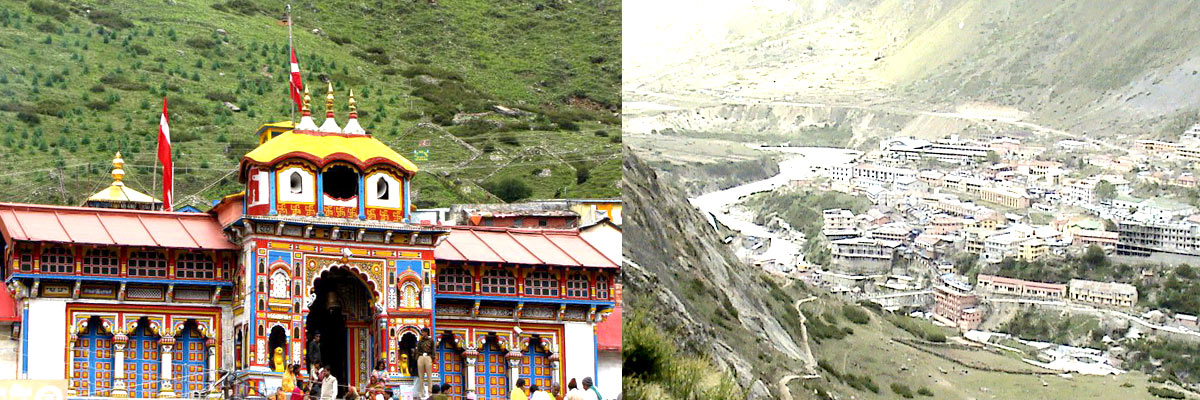
Badrinath Dham – Complete Information
Overview
Badrinath Dham is one of the most sacred Hindu pilgrimage sites and part of the Char Dham and Chota Char Dham circuits in India. It is dedicated to Lord Vishnu and is located in the Chamoli district of Uttarakhand. Nestled in the Garhwal Himalayas at an altitude of about 3,300 meters (10,827 feet), the temple is situated on the banks of the Alaknanda River.BADRINATH TEMPLE:
Dedicated to Lord Vishnu, it is built in the form of a cone with a small cupola of a gilt bull & spire. Legend dates the temple prior to the vedic age and the original temple is believed to be built by King Pururava and the icon of the lord carved by Vishwakarma, the creator of gods. A Hindu reformist Adi Shankaracharya re-enshrined the temple back in 8th century. A flight of steps takes pilgrims to the main gate & then into the temple. The temple is divided into three parts - the 'Garbha Griha' or the sanctum sanctorum, the 'Darshan Mandap' where the rituals are conducted and the 'Sabha Mandap' where devotees assemble. The Garbha Griha portion has its canopy covered with a sheet of gold offered by Queen Ahilyabai Holkar. The complex has 15 idols. especially attractive is the one-metre high image of Badrinath, finely sculpted in black stone. It represents Lord Vishnu seated in a meditative pose-padmasan.
Special pujas are also performed on behalf of individuals. Every puja must be preceded by a holy dip in the Tapta Kund. Some of the special morning pujas are Abhishek, Mahaabhishek, Geeta Path. Some special evening pujas are Aarti & Geet Govind. Such pujas are to be booked in advance. The temple opens at 0430 hrs & closes at 1300 hrs. Once again it opens at 1600 hrs & closes at 2100 hrs after the divine song Geet Govind. Rawal is the administrator-Pujari of the temple well versed in puja ceremonials & Sanskrit language and is expected to be celibate.
Geographic Details of Badrinath
Area: 4.5 Sq.kms
Altitude: 3133 MTS.
Rainfall:1460 m
Temperature: Summer - Max 17.9° C, Min 5.9° C, Winter- Generally snowbound from December to March
Best Season: April to November.
Clothing: woolen garments required throughout.
Badrinath Dham Accessibility Air: Nearest airport is a Jolly grant, 314kms.
Rail: Nearest railhead is Rishikesh, 297kms.
Road: Badrinath is connected by road with important places like Rishikesh, Delhi (518Kms), Kotdwar, Dehradun.
Religious Significance
Badrinath is considered one of the 108 Divya Desams (holy abodes of Vishnu) as per Vaishnavism.According to legend, Adi Shankaracharya rediscovered the idol of Lord Vishnu in the Alaknanda River and enshrined it in the temple in the 8th century.
The temple is believed to be the site where Lord Vishnu meditated under the Badri tree (a type of jujube tree) in deep penance.
It is also associated with Mahabharata, as the Pandavas are believed to have passed through here on their journey to heaven.
Badrinath Temple Architecture
The Badrinath Temple is a 15-meter-tall structure built in traditional Garhwali architecture.The facade features a colorful entrance, known as Singh Dwar.
Inside the sanctum (Garbha Griha), the 1-meter-tall black stone idol of Lord Vishnu (Badri Vishal) is seated in Padmasana (lotus posture).
The temple complex also includes mandapas (pillared halls) and a sanctum sanctorum with other deities.
Major Attractions Around Badrinath
Tapt KundA natural hot water spring believed to have medicinal properties.
Pilgrims take a dip here before visiting the temple.
Neelkanth Peak
A majestic snow-covered peak (6,597 meters) providing a breathtaking backdrop to the temple.
Called the "Garhwal Queen", it is named after Lord Shiva.
Mana Village
The last village of India near the Indo-Tibetan border.
Home to ancient sites like Vyas Gufa (where Maharishi Vyasa composed the Mahabharata) and Bheem Pul (a massive stone bridge believed to be placed by Bheem).
Charan Paduka
A sacred rock believed to bear the footprints of Lord Vishnu.
A short trek from Badrinath Temple.
Vasudhara Falls
A stunning waterfall (122 meters high), believed to shower water only on those free of sins.
Accessible via a 6 km trek from Mana Village.
Satopanth Tal
A high-altitude glacial lake (4,600 meters) associated with the Trimurti (Brahma, Vishnu, and Shiva).
A challenging trek from Badrinath, attracting adventure seekers.
Badrinath Temple Opening & Closing
The temple opens in April/May (on Akshaya Tritiya) and closes in October/November (on Bhai Dooj).
The idol is moved to Joshimath's Narasimha Temple for winter worship.
Best Time to Visit
May to June (pleasant weather, peak pilgrimage season).
September to October (post-monsoon, lesser crowds, beautiful landscapes).
Avoid monsoons (July-August) due to landslides and heavy rain.
How to Reach Badrinath Dham?
By AirNearest Airport: Jolly Grant Airport, Dehradun (311 km)
Helicopter services available from Dehradun to Badrinath.
By Train
Nearest Railway Station: Rishikesh (293 km)
Haridwar and Dehradun are alternative railway stations.
By Road
Well-connected by roads from Haridwar, Rishikesh, and Dehradun.
Regular buses, taxis, and private vehicles available.
Accommodation & Facilities
Hotels, Dharamshalas, and Guest Houses available near the temple.GMVN (Garhwal Mandal Vikas Nigam) provides budget accommodations.
Food facilities are mostly vegetarian as per temple norms.
Things to Keep in Mind
✔ Carry warm clothes, as temperatures can drop significantly.✔ Stay hydrated and acclimatize to avoid altitude sickness.
✔ Follow temple dress codes (traditional attire preferred).
✔ Check weather and road conditions before traveling.



